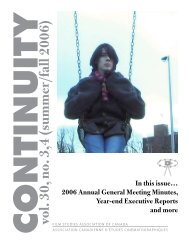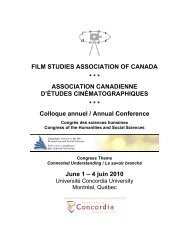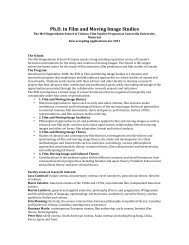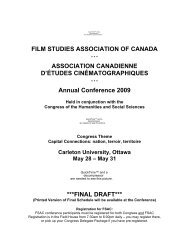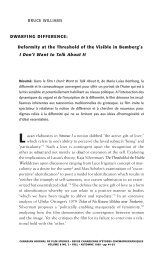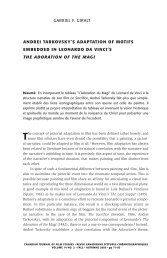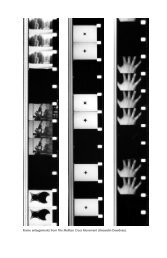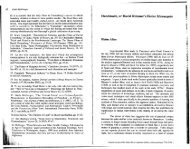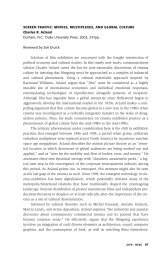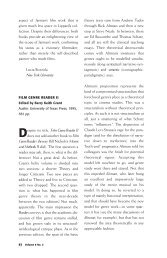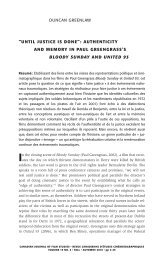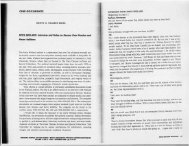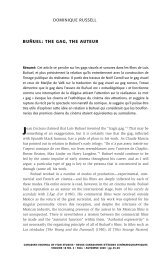cinematic experience, film space, and the child's world - Film Studies
cinematic experience, film space, and the child's world - Film Studies
cinematic experience, film space, and the child's world - Film Studies
Create successful ePaper yourself
Turn your PDF publications into a flip-book with our unique Google optimized e-Paper software.
005.Kuhn.19.2:005.Kuhn. 11/18/10 5:32 PM Page 97<br />
2. D.W. Winnicott, “Transitional Objects <strong>and</strong> Transitional Phenomena” (1951), in Through<br />
Paediatrics to Psychoanalysis: Collected Papers (London: Karnac Books, 2002), 240. The<br />
essay is reprinted in D.W. Winnicott, Playing <strong>and</strong> Reality (London: Routledge, 2005).<br />
3. This became <strong>the</strong> title of a posthumously published collection of essays: D. W. Winnicott,<br />
Home Is Where We Start From (Harmondsworth: Penguin, 1986).<br />
4. Anni Bergman, “From Mo<strong>the</strong>r to <strong>the</strong> World Outside: The Use of Space During <strong>the</strong><br />
Separation—Individuation Phase,” in Between Reality <strong>and</strong> Fantasy: Winnicott’s Concepts<br />
of Transitional Objects <strong>and</strong> Phenomena, eds. Simon A Grolnick <strong>and</strong> Leonard S. Barkin<br />
(Northvale, NJ: Jason Aronson, Inc., 1995), 160.<br />
5. Ibid., 164, emphasis added.<br />
6. D.W. Winnicott, “Playing: a Theoretical Statement,” in Playing <strong>and</strong> Reality (London:<br />
Routledge, 2005), 69.<br />
7. Ibid.<br />
8. Gaston Bachelard, The Poetics of Space (Boston, MA: Beacon Press,1969), 13.<br />
9. Winnicott, “Playing: a Theoretical Statement,” 69.<br />
10. Quoted in M. Davis <strong>and</strong> D. Wallbridge, Boundary <strong>and</strong> Space: An Introduction to <strong>the</strong> Work<br />
of D.W. Winnicott (London: Karnac Books, 1990), 144; see also D. W. Winnicott, “On<br />
Security,” The Family <strong>and</strong> Individual Development (London: Tavistock, 1965), 30-33.<br />
11. Bergman, 148.<br />
12. Ibid.<br />
13. Ibid., 149.<br />
14. Ibid., 159.<br />
15. Michael Balint, Thrills <strong>and</strong> Regressions (London: Hogarth Press, 1959).<br />
16. See, for example, Stuart C. Aitken <strong>and</strong> Thomas Herman, “Gender, Power <strong>and</strong> Crib<br />
Geography: Transitional Spaces <strong>and</strong> Potential Places,” Gender, Place <strong>and</strong> Culture 4, no.1<br />
(1997): 63-88.<br />
17. Roger Hart, Children’s Experience of Place (New York: Irvington Publishers, Inc., 1979),<br />
331-332.<br />
18. Ibid., 333.<br />
19. On creativity <strong>and</strong> cultural <strong>experience</strong>, see Christopher Bollas, “The Aes<strong>the</strong>tic Moment <strong>and</strong><br />
<strong>the</strong> Search for Transformation,” in Transitional Objects <strong>and</strong> Potential Spaces: Literary<br />
Uses of D.W. Winnicott, ed. Peter L. Rudnytsky (New York: Columbia University Press,<br />
1993), 40-49; Marion Milner, “The Role of Illusion in Symbol Formation,” in Transitional<br />
Objects <strong>and</strong> Potential Spaces: Literary Uses of D.W. Winnicott, ed. Peter L. Rudnytsky<br />
(New York: Columbia University Press, 1993), 13-39; Lesley Caldwell, ed., Art, Creativity,<br />
Living, Winnicott <strong>Studies</strong> Monograph Series (London: Karnac Books for <strong>the</strong> Squiggle<br />
Foundation, 2000).<br />
20. Object-relations approaches to <strong>the</strong> metapsychology of <strong>the</strong> <strong>cinematic</strong> <strong>experience</strong> are discussed,<br />
from a psychoanalytic st<strong>and</strong>point in Graham Clarke, “Notes Towards an Object-<br />
Relations Approach to Cinema”, Free Associations 4 no.3 (1994): 369-390; Ira<br />
Konigsberg, “Transitional Phenomena, Transitional Space: Creativity <strong>and</strong> Spectatorship in<br />
<strong>Film</strong>,” Psychoanalytic Review 83, no.6 (1996): 865-889; Phyllis Creme, The Playing<br />
Spectator: A Study on <strong>the</strong> Applicability of <strong>the</strong> Theories of D.W. Winnicott to<br />
Contemporary Concepts of <strong>the</strong> Viewer’s Relationship to <strong>Film</strong>, PhD <strong>the</strong>sis, University of<br />
Kent, 1994.<br />
21. Jerry White, “Children, Narrative <strong>and</strong> Third Cinema in Iran <strong>and</strong> Syria,” Canadian Journal<br />
of <strong>Film</strong> <strong>Studies</strong> 11, no.1 (2002): 78-97, contains an illuminating discussion of Where is<br />
<strong>the</strong> Friend’s Home?<br />
22. The cultural-historical significance of this bombsite is discussed in Annette Kuhn, “M<strong>and</strong>y<br />
<strong>and</strong> Possibility,” Screen 33, no.3 (1992): 233-243.<br />
23. Philip Kemp, Lethal Innocence: The Cinema of Alex<strong>and</strong>er Mackendrick (London:<br />
Methuen, 1991).<br />
CINEMATIC EXPERIENCE, FILM SPACE, AND THE CHILD’S WORLD 97



